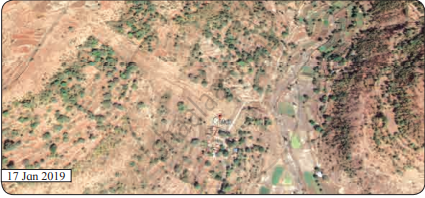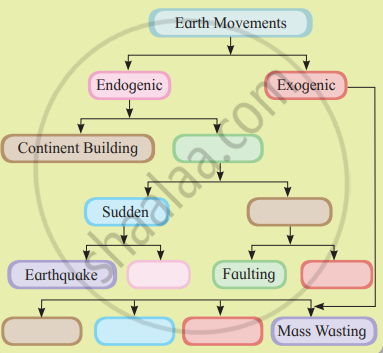Advertisements
Chapters
![Balbharati solutions for Geography (Social Science) [English] 11 Standard chapter 2 - Weathering and Mass Wasting Balbharati solutions for Geography (Social Science) [English] 11 Standard chapter 2 - Weathering and Mass Wasting - Shaalaa.com](/images/geography-social-science-english-11-standard_6:acdc1b8f00d74d0085a22ac1e29ad6d2.jpg)
Advertisements
Solutions for Chapter 2: Weathering and Mass Wasting
Below listed, you can find solutions for Chapter 2 of Maharashtra State Board Balbharati for Geography (Social Science) [English] 11 Standard.
Balbharati solutions for Geography (Social Science) [English] 11 Standard 2 Weathering and Mass Wasting Let’s recall [Page 15]
Study the diagram and answer the following questions:

- Identify the types of rocks shown in the diagram.
- Arrange the rocks according to their chronology of origin.
- Explain how sedimentary rocks are formed.
- Think of all the factors which may break the rocks into smaller pieces.
- Which type of rock will break easily as compared to others? Why?
Balbharati solutions for Geography (Social Science) [English] 11 Standard 2 Weathering and Mass Wasting Use your brain power! [Pages 19 - 20]
Can animals and plants also influence weathering? Will that be physical or chemical weathering? Which type of weathering does stone quarrying cause?
A region is having an annual mean temperature of 5°C and an annual rainfall of 1000 mm. Can you comment upon the weathering and the type with the help of the following questions? Discuss in class.
- Which type of weathering will be dominant here?
- Where will such a region be found?
Balbharati solutions for Geography (Social Science) [English] 11 Standard 2 Weathering and Mass Wasting Think about it. [Pages 17 - 25]
In which regions will freeze-thaw weathering not be effective?
Besides climatic factors, rock type, and structure, can you think of some more factors that affect weathering?
Can tectonic forces be responsible for mass movements?
There is a shift of materials in mass movements as well as in transportation from one place to the other. So, why can’t both not be treated as one and the same?
Balbharati solutions for Geography (Social Science) [English] 11 Standard 2 Weathering and Mass Wasting Can you tell? [Page 21]
See the diagram and answer the following questions:

- Which rock layer has experienced the most weathering?
- Which rock layer has experienced the least weathering?
- What could be the reason behind the difference in weathering?
The satellite images are given in figure A and B belong to the same location but a different timeline. Study the images and answer the following questions.

Figure A

Figure B
- Compare the images and tell what differences do you find in these images.
- In 2019 what does the patch of land going from north-west to south-east signify? Why was it not there in the 2011 image?
- To what extent is the climate of the place responsible for this disaster?
- Which other factors are responsible for the disaster?
Balbharati solutions for Geography (Social Science) [English] 11 Standard 2 Weathering and Mass Wasting Give it a try. [Pages 23 - 25]
Study the following schematic diagram. It shows the relationship between the speed of material and moisture content. Read the index, and answer the following questions:

- Fast
- Slow
- Dry
- Wet
- Creep
- Slide
- Fall
- Flow
Question:
- What will happen when the weather conditions are dry?
- When will a flow occur?
- When will a creep occur?
- Now can you enumerate the factors which affect mass wasting?
On the basis of the given points, differentiate between weathering and erosion.
| Weathering | Erosion | |
| Definition | ||
| Causes/Agents | ||
| Effect/Results | ||
| Examples |
Balbharati solutions for Geography (Social Science) [English] 11 Standard 2 Weathering and Mass Wasting Think a little [Page 24]
Think of the reason why landslides should be more frequent in the foothill zone of the Himalayas and Western Ghat region. Why do landslides not occur in Marathwada in Maharashtra or the Maidan area in Karnataka?
Balbharati solutions for Geography (Social Science) [English] 11 Standard 2 Weathering and Mass Wasting Try this [Pages 24 - 25]
Different types of materials flow down the slope. Types of mass wasting depend on their speed. Observe the pictures given in the figure. Match the explanation given below with the diagrams. Identify them as slow or rapid movements.

Types of mass Wasting
Complete the following flowchart.

Balbharati solutions for Geography (Social Science) [English] 11 Standard 2 Weathering and Mass Wasting Exercise [Pages 25 - 26]
Complete the chain:
| Rock type | Name of the rock | Dominant type of weathering |
| 1) Igneous | 1) Dolomite | 1) Physical Weathering |
| 2) Sedimentary | 2) Slate | 2) Chemical Weathering |
| 3) Metamorphic | 3) Basalt | |
| 4) Limestone | ||
| 5) Granite |
Identify the correct correlation:
A: Assertion; R: Reasoning
A: In areas of high rainfall, slides are very common.
R: Types of mass wasting movements are dependent on a region's climate.
Only A is correct
Only R is correct
Both A and R are correct and R is the correct explanation of A.
Both A and R are correct but R is not the correct explanation of A.
Identify the correct correlation:
A: Assertion; R: Reasoning
A: Gravity is a major factor in mass wasting.
R: Gravity pulls all things down to the earth's surface.
Only A is correct
Only R is correct
Both A and R are correct and R is the correct explanation of A.
Both A and R are correct but R is not the correct explanation of A.
Identify the correct correlation:
A: Assertion; R: Reasoning
A: Freeze and thaw weathering is common in desert areas.
R: Water gets into cracks and breaks the rocks.
Only A is correct
Only R is correct
Both A and R are correct and R is the correct explanation of A.
Both A and R are correct but R is not the correct explanation of A.
Identify the correct correlation:
A: Assertion; R: Reasoning
A: Surface water helps solifluction.
R: Water table is responsible for the same.
Only A is correct
Only R is correct
Both A and R are correct and R is the correct explanation of A.
Both A and R are correct but R is not the correct explanation of A.
Identify the correct group:
- Oxidation
- Carbonation
- Freeze-thaw weathering
- Shattering
- Solution
- Salt Weathering
- Oxidation
- Carbonation
- Fall
- Creep
- Slide
- Flow
- Pressure
- Temperature
- Slope
- Rainfall
Give a geographical reason:
Temperature is the main factor behind granular weathering.
Give a geographical reason:
Human is an agent of weathering.
Give a geographical reason:
Slope is a major factor in mass wasting.
Give a geographical reason:
Oxidation changes the size and colour of the rocks.
Give a geographical reason:
Effect of mass movement will be greater along the western slope of the Sahyadri's than the eastern slope.
Write a short note on Gravity and Solifluction
Write a short note on Role of water in mass wasting
Write a short note on Exfoliation
Write a short note on Weathering and homogeneity in rocks.
Write a short note on Carbonation
Draw a neat and labelled diagram of Freeze and thaw weathering
Draw a neat and labelled diagram of Block disintegration.
Draw a neat and labelled diagram of Biological weathering.
Answer in detail:
Explain with examples the process of weathering happening in Konkan.
Answer in detail:
Explain the correlation between the Himalayas and mass movements. Give examples wherever necessary.
Solutions for 2: Weathering and Mass Wasting
![Balbharati solutions for Geography (Social Science) [English] 11 Standard chapter 2 - Weathering and Mass Wasting Balbharati solutions for Geography (Social Science) [English] 11 Standard chapter 2 - Weathering and Mass Wasting - Shaalaa.com](/images/geography-social-science-english-11-standard_6:acdc1b8f00d74d0085a22ac1e29ad6d2.jpg)
Balbharati solutions for Geography (Social Science) [English] 11 Standard chapter 2 - Weathering and Mass Wasting
Shaalaa.com has the Maharashtra State Board Mathematics Geography (Social Science) [English] 11 Standard Maharashtra State Board solutions in a manner that help students grasp basic concepts better and faster. The detailed, step-by-step solutions will help you understand the concepts better and clarify any confusion. Balbharati solutions for Mathematics Geography (Social Science) [English] 11 Standard Maharashtra State Board 2 (Weathering and Mass Wasting) include all questions with answers and detailed explanations. This will clear students' doubts about questions and improve their application skills while preparing for board exams.
Further, we at Shaalaa.com provide such solutions so students can prepare for written exams. Balbharati textbook solutions can be a core help for self-study and provide excellent self-help guidance for students.
Concepts covered in Geography (Social Science) [English] 11 Standard chapter 2 Weathering and Mass Wasting are Weathering, Introduction of Weathering and Mass Wasting, Types of Weathering, Different Rates of Weathering, Importance of Weathering, Mass Movements (Mass Wasting), Types of Mass Wasting, Erosion.
Using Balbharati Geography (Social Science) [English] 11 Standard solutions Weathering and Mass Wasting exercise by students is an easy way to prepare for the exams, as they involve solutions arranged chapter-wise and also page-wise. The questions involved in Balbharati Solutions are essential questions that can be asked in the final exam. Maximum Maharashtra State Board Geography (Social Science) [English] 11 Standard students prefer Balbharati Textbook Solutions to score more in exams.
Get the free view of Chapter 2, Weathering and Mass Wasting Geography (Social Science) [English] 11 Standard additional questions for Mathematics Geography (Social Science) [English] 11 Standard Maharashtra State Board, and you can use Shaalaa.com to keep it handy for your exam preparation.
